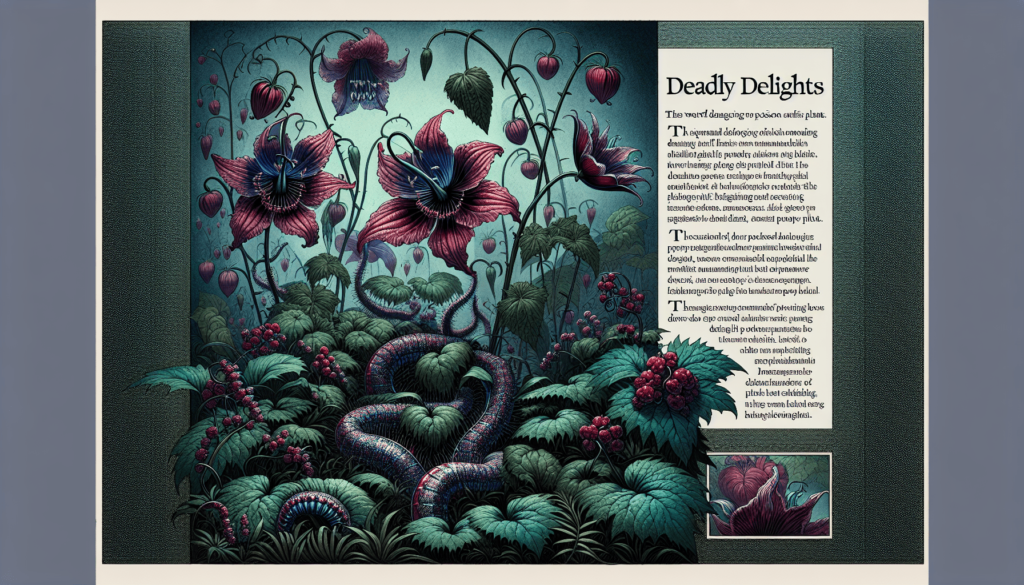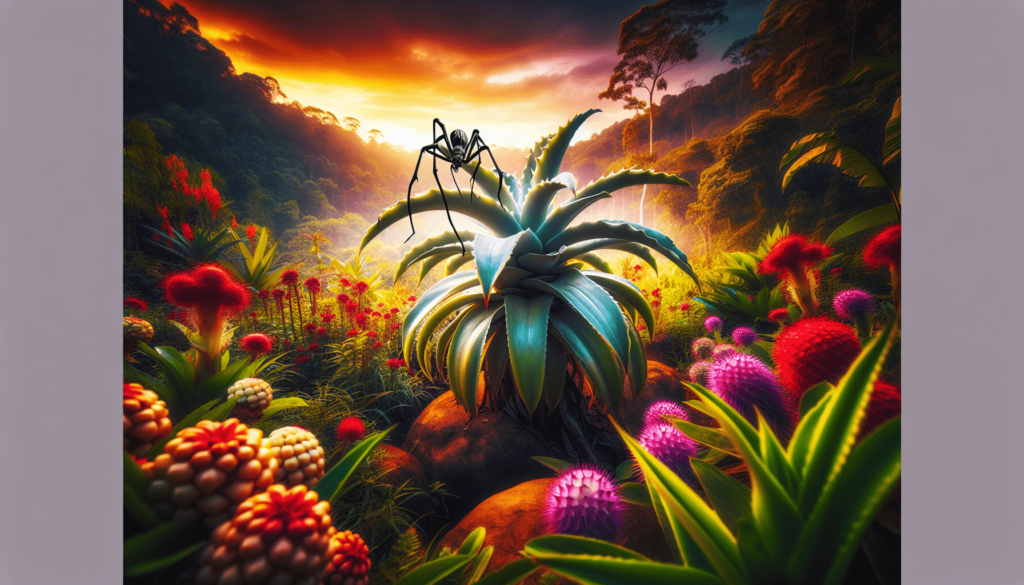Imagine embarking on an off-grid adventure, where you and your family become self-sufficient and live off the land. In your backyard, a thriving survival garden provides you with fresh produce, while you learn to identify wild plants for sustenance. But in this exciting journey, there are potential dangers lurking in the form of poisonous plants. That’s why it’s crucial to know which wild plants could be deadly and how to identify them. From the lethal nightshade to the deceptive poison hemlock, this article will guide you through the world of deadly wild plants, ensuring that you can enjoy the beauty of nature while staying safe. So, get ready to delve into the realm of deadly delights and equip yourself with life-saving knowledge.

Introduction
In the world of nature, beauty can sometimes hide danger. As you venture into the wilderness, it’s essential to be aware of the potential hazards that surround you, especially when it comes to plants. While many plants offer sustenance and medicinal properties, there are others that can be deadly if ingested or even touched. In this article, we will explore ten wild plants that could kill you and discuss how to identify them. By familiarizing yourself with these deadly delights, you can better protect yourself and your loved ones while enjoying the great outdoors.
1. Belladonna (Atropa Belladonna)
Belladonna, also known as deadly nightshade, is a highly toxic plant with a dark and intriguing history. Its shiny black berries may look tempting, but consuming them can cause severe poisoning symptoms, including hallucinations, rapid heartbeat, and even paralysis. To identify belladonna, look for its distinctive bell-shaped purple flowers, which bloom in late summer. The plant also features large, oval-shaped leaves that are smooth and slightly wavy. Be cautious when encountering belladonna, as even a small amount can be lethal.
2. Hemlock (Conium maculatum)
Hemlock is another lethal plant that you must steer clear of. It is infamous for its role in the execution of the philosopher Socrates. Hemlock leaves and flowers contain highly toxic alkaloids that can cause paralysis and respiratory failure. To identify hemlock, look for its tall, hollow stem with purple spots and distinctive clusters of small white flowers. The leaves are fern-like and pinnately compound, with small teeth along the edges. Remember, consuming any part of this plant can be fatal, so it’s crucial to avoid it at all costs.
3. Oleander (Nerium oleander)
Oleander, with its beautiful and vibrant flowers, is often found in gardens and landscapes. However, this seemingly innocent plant harbors a dark secret. All parts of the oleander plant contain a toxic compound called oleandrin, which can affect the heart and cause severe illness or death if ingested. To identify oleander, look for its evergreen, leathery leaves that grow in opposite pairs along the stem. The flowers can be white, pink, or red and have a pleasant fragrance. It’s important to handle oleander with caution and avoid any contact with its sap or flowers.

4. Deadly Nightshade (Atropa belladonna)
As the name suggests, deadly nightshade is one of the most poisonous plants in existence. All parts of this plant, including the berries, leaves, and roots, contain toxic alkaloids that can cause a wide range of symptoms, from hallucinations to cardiac arrest. To identify deadly nightshade, look for its purple bell-shaped flowers that grow in clusters, along with its shiny black berries. The plant has large, broad leaves with pointed tips. Exercise extreme caution around deadly nightshade, and never consume or handle it without proper protection.
5. Water Hemlock (Cicuta maculata)
Water hemlock is a highly poisonous plant that grows in wet habitats such as swamps and marshlands. It contains a potent toxin called cicutoxin, which can cause violent seizures and respiratory failure if ingested. To identify water hemlock, look for its clusters of small white flowers that resemble an umbrella or an upside-down umbrella. The plant has fern-like leaves with saw-tooth edges and a hollow, chambered stem. Due to its high toxicity, it’s crucial to avoid water hemlock at all costs, especially when foraging for edible plants near bodies of water.
6. Foxglove (Digitalis purpurea)
With its tall stalks adorned with colorful bell-shaped flowers, foxglove is a favorite among garden enthusiasts. However, this attractive plant contains cardiac glycosides, which can cause abnormal heart rhythms and, in severe cases, be fatal. To identify foxglove, look for its tubular flowers that come in various shades of pink, purple, and white. The plant has large, soft, hairy leaves arranged in a rosette pattern at the base. While foxglove can be deadly, it has also been used medicinally in controlled doses, highlighting the importance of understanding a plant’s potential dangers.
7. Poison Ivy (Toxicodendron radicans)
Poison ivy is a familiar plant to many, known for its ability to cause painful rashes and irritation. It contains a clear liquid called urushiol, which can cause an allergic reaction in most people. While poison ivy itself may not be lethal, the severe itching and discomfort it causes can result in secondary infections. To identify poison ivy, look for its three leaflets that alternate along the stem. The leaves are shiny, and their edges can be smooth or toothed. Remember, “leaves of three, let them be” is a helpful catchphrase to remind yourself to stay away from this troublesome plant.
8. Castor Bean (Ricinus communis)
Although castor beans are commonly associated with the production of castor oil, they also harbor a dangerous secret. The beans themselves contain ricin, a potent toxin that can be deadly if ingested or injected. To identify the castor bean plant, look for its large, lobed leaves with serrated edges and its clusters of small green flowers that mature into spiky seed pods. Exercise extreme caution around castor bean plants and ensure they are kept out of reach, especially in households with children or pets.
9. White Snakeroot (Ageratina altissima)
White snakeroot is a toxic plant native to North America. It contains a poisonous alcohol called tremetol, which can cause a condition called milk sickness in humans and animals if ingested. The name “milk sickness” stems from incidents where people consumed the meat or drank the milk of animals that had grazed on white snakeroot, leading to illness or even death. To identify white snakeroot, look for its clusters of small white flowers and its broad, toothed leaves. Awareness of this plant is crucial when foraging for edible wild plants or raising livestock in areas where it grows.
10. Death Cap Mushroom (Amanita phalloides)
Last but certainly not least, the death cap mushroom is one of the deadliest fungi known to humans. It contains amatoxins, which can cause severe liver and kidney damage and is often lethal if ingested. To identify the death cap mushroom, look for its pale yellow-greenish cap, white gills, and a bulbous base with a skirt-like ring. It’s important to note that identifying mushrooms can be challenging and potentially dangerous, so it’s best to avoid foraging for mushrooms unless you’re an experienced mycologist.
Conclusion
Nature is a vast and diverse tapestry, and venturing into the wild can be a rewarding and enriching experience. However, it’s essential to approach it with caution and respect, especially when it comes to identifying potentially deadly plants. By familiarizing yourself with the characteristics of these ten deadly delights, you can navigate the natural world more confidently, protecting yourself and your loved ones from potential harm. Remember, knowledge is power, and armed with the ability to identify these dangerous plants, you can enjoy nature’s wonders while staying safe and secure.

